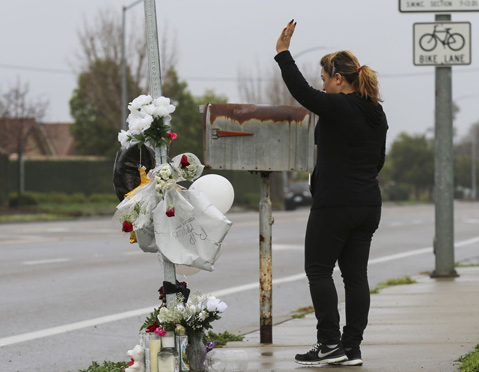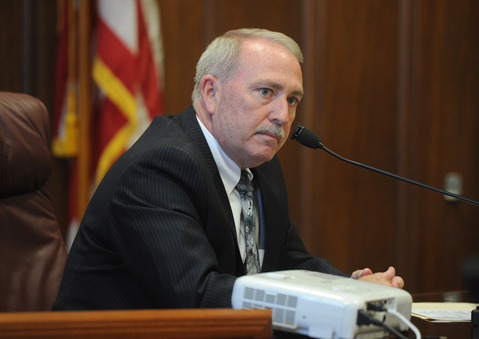Santa Maria: Murder City
January Killings Unprecedented

In just last month, Santa Maria saw more murders than all the cities of Oakland, Sacramento, and San Jose combined. On January 25, Carlos Perez, 14, and Israel Cruz, 19, were found hiding in a dried-out patch of the riverbed after allegedly killing 15-year-old Marcos Ramos with a meat hook near Pioneer Valley High School. Just before 10 p.m. that night, a few blocks away, two men riding in a car were shot to death. On January 13, two 23-year-olds were shot on the corner of Main Street and Oakley Avenue. One was pronounced dead at the scene; the other died at the hospital.
Santa Maria Police Chief Ralph Martin, who came from the Los Angeles County Sheriff’s Department in 2012 to take over a divided department, called the recent killings “unprecedented,” and the gang-related crime in the past year “a huge uptick.” In recent years, the city of about 110,000 people averaged three to four gang-related murders, but the January deaths marked the 14th gang-related homicide and 19th death since the start of 2015. Since then, just Perez and Cruz have been arrested; the rest are open investigations.
Last week, Martin’s officers initiated a low-profile gang sweep, also known as a “compliance check.” Teams of law enforcement officers looked up parolees. Up to 1,400 gang members or associates live in Santa Maria, according to police. Only five arrests were made.
It is impossible to overstate the magnitude of the recent carnage. The weapons of choice run the gamut—machetes, knives, guns. The reasons for the spike are not largely understood. Unlike most cities, two established street gangs — West Park and Northwest — operate in undefined territories. They are intermingled; sometimes members of opposing gangs live on the same street. When city officials looked into implementing a gang injunction a number of years ago, there were multiple street gangs, and the geographic areas were even more unclear. “It doesn’t work at all,” city spokesperson Mark Van de Kamp said of an injunction.
It is no secret that if the city of Santa Barbara experienced gang crime of a similar magnitude, the citizenry would be up in arms, demanding action. After all, fewer murders ignited the three-year legal battle for a gang injunction, which a judge ultimately threw out.
So why the surge in Santa Maria now? Several sources not usually media shy offered educated speculation but asked that their names not be used. Below is a summation of their theories:
Theory number one is that the violence stems out of a struggle between Los Angeles and Northern California gangs to control the drug trade in Santa Maria. Though the city is largely considered to be in Southern California, a dozen or so admitted Norteño gangmembers wind up in County Jail each year. Hundreds associated with the Sureños are booked each year. These numbers have stayed the same in recent years.
Most gang violence tends to occur on the city’s northwest side, where overcrowded, rundown apartments generate more crime and more calls for service. But of late, other random parts of the city have been crime scenes, as well. Theory two suggests the bloodshed erupted out of those conditions. In addition, the two street gangs exist in cyclical retaliation.

Theory three says the violence isn’t that unusual. Last year was also an anomaly in homicides for Bakersfield, Oxnard, and Salinas. A Salinas police spokesperson said multiple-death incidents contributed to an increase as well as a surge in domestic violence.
Santa Maria has seen an increase in heroin overdoses in the past year, police say, a noticeable addition to cocaine and meth.
Whatever the explanation is, getting witness accounts proves difficult. A distrust of the system is especially pervasive in Santa Maria’s lower socioeconomic Latino families. Undocumented people might fear going to the police to report crime. “I understand that,” Martin said. People can remain anonymous, he said. Last week, Martin went before the city council to plead with the community for cooperation. City officials have put in 10 or so cameras; they plan to add 30 more.
Peter Flores of One Community Action, an outreach group, said the elephant in the room is hatred. “When you see things [online] like, ‘Just let them kill themselves’ … When you say ‘they’ and ‘them,’” he said, “that’s us; that’s our community. There is something to be said about discrimination.” One law enforcement official agreed that sentiment exists.
When asked if some kids have a choice in joining gangs or if they must join, Flores said the issue is complex. “It’s obviously very hard being brought up in that environment to get out of it,” he said.
“Kids want barriers,” said Gabriel Morales, who has worked with underrepresented youth for three decades. “They want direction.” He just learned with dismay the city no longer has a youth commission.
Fifth District Supervisor Steve Lavagnino — who grew up in Santa Maria the son of the city’s mayor — expressed anguish and shock over the murders. He married a Latina whose mother worked in the fields; she has nine brothers and sisters. “Every single one of those kids is a productive member [of society],” he said. “There are people all over that area that went on to do great things. I don’t know where that’s gone or what’s happened.”
To the degree Santa Maria is segregated, he said, does not explain the explosion of violence. Seventy-two percent of his district is Hispanic. “Right now I’m concerned about two things: suppression and, number two, the long-term outlook on what is going on with our families,” he said.



